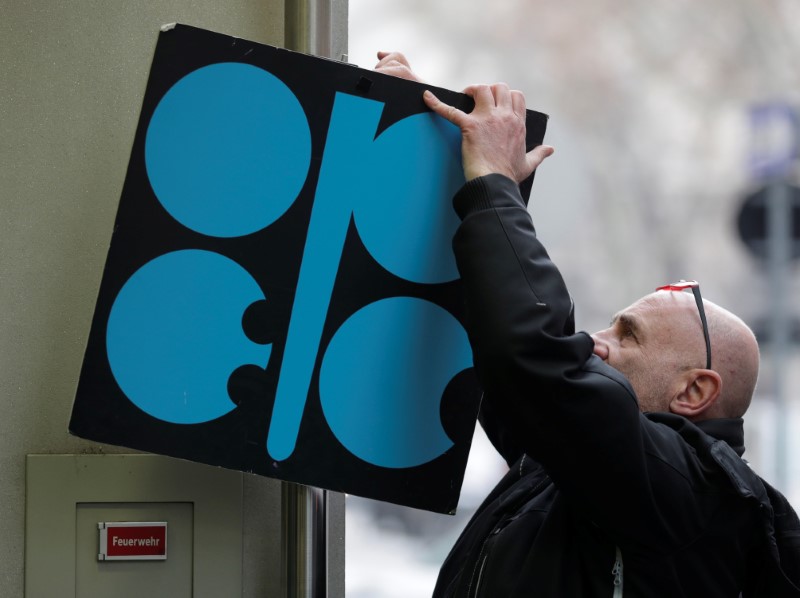By Amanda Cooper
LONDON (Reuters) - Saudi Arabia's proposals of new metrics to determine when the oil market is balanced signals a shift in OPEC's targets for a pact on supply cuts that has almost achieved the initial aim of reducing bloated inventories.
The Organization of the Petroleum Exporting Countries, Russia and nine other producers cut output from January 2017 by 1.8 million barrels per day (bpd) with the aim of reducing crude stocks in industrialized OECD nations to the five-year average.
From a record 3.1 billion barrels in July 2016, OECD stocks dropped to 2.851 billion barrels in December, falling 216 million barrels during 2017 and now stand just 52 million barrels above the five-year average, International Energy Agency (IEA) data show.
OPEC and its allies have been helped because the five-year average is a moving target and has risen even as output curbs were in place. The average climbed to 2.86 billion barrels in September 2017 from about 2.73 billion barrels when the supply pact was sealed in late 2016.
"After a period of surplus, the target becomes easier over time as more surplus years are included," said Standard Chartered (LON:STAN) head of commodities research Paul Horsnell.
But as the OECD inventory target has shifted so has thinking in Saudi Arabia, the world's biggest oil exporter that worked with Russia to forge the global pact on cutting supplies.
Saudi Energy Minister Khalid al Falih says OPEC and its partners should look at metrics such as non-OECD inventories, oil in floating storage and crude in transit as they consider the future of the pact that is due to expire at the end of 2018.
Those measures, however, are more difficult to monitor.
Non-OECD oil demand has outstripped OECD consumption since 2014. But inventories in non-OECD nations tend to be held as strategic not commercial assets, making them less transparent and less likely to shift with changes to demand or supply.
FORWARD DEMAND
Falih has said it would be better to "overbalance" the market, by which he means allowing OECD stocks to drop below the five-year average, rather than end the supply deal too early, another hint that the pact's expiry could be pushed back.
To assess whether supply and demand had achieved a sustainable balance, OPEC could measure the amount of oil in storage against days of demand it covers. This would show whether consumption was enough to avoid rebuilding inventories.
(Graphic: Global oil supply and demand fall into line - http://reut.rs/2Dm6vF7)
The amount of oil stored in OECD nations is now equivalent to 61 days of forward demand, the lowest since February 2015.
In the two years to mid-2014 when the oil price hit about $115, the number of days cover remained below 60. When OPEC and its partners sealed the supply deal in late November in the wake of an oil price plunge, there were nearly 64 days cover.
But measuring forward cover may still only offer limited help to OPEC in determining the right time to reopen oil taps, given output from the United States and other non-OPEC producers is climbing. This has capped oil prices around $65 a barrel now, after rising from below $30 at the start of 2016.
PVM Oil Associates analyst Tamas Varga said OPEC and its partners must "constantly remind the market that the alliance formed at the end of 2016 is more than a marriage of convenience and no divorce is contemplated even after stability is achieved."
The IEA says oil producers outside the supply pact raised output by about 700,000 bpd in the 12 months to January. If OPEC members Libya and Nigeria, which are exempt from supply curbs, are included, the total rises to 1.4 million bpd.
By comparison, world demand grew 1.6 million bpd in 2017.
OPEC forecasts global demand will grow by 1.59 million bpd in 2018, compared to the IEA prediction of 1.4 million bpd. OPEC also sees non-OPEC supply rising by 1.4 million bpd in 2019, compared to the IEA forecast of 1.7 million bpd.
"OPEC and Russia would probably be better off signaling a gradual approach or a 'tapering' of sorts," analysts at Bank of America-Merrill Lynch said, adding they should signal output would only rise once the pact ends if oil prices held steady.
(For a graphic of IEA estimates of OECD oil inventories since 2016 click http://reut.rs/2GQJL2j)
(For a graphic of IEA vs OPEC forecasts for global oil demand growth in 2018 click http://reut.rs/2CrxByI)
(For a graphic of Annual changes in OPEC vs U.S. oil output click http://reut.rs/2DnK56t)
